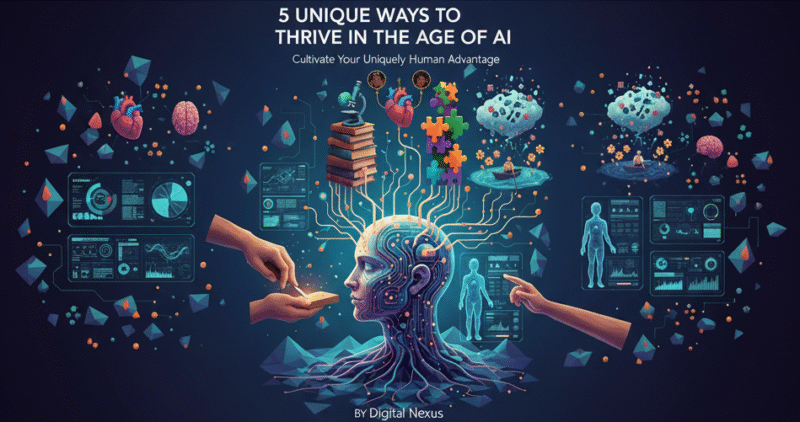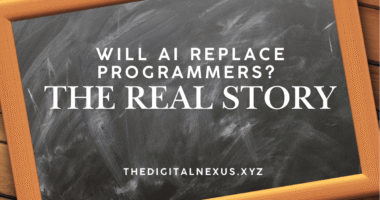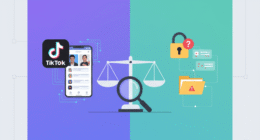The rise of artificial intelligence isn’t just a technological shift; it’s a fundamental change in how we work, learn, and define our own value. While many focus on learning to code or use specific AI tools, true long-term success lies in cultivating uniquely human skills that AI can augment but not replace. Instead of competing with machines on their terms—computation and data processing—the goal is to double down on the qualities that make us human. Here are five unique strategies to not just survive but thrive in the age of AI.
1. Cultivate “Analog” Intelligence and Embodied Cognition
In a world saturated with digital information and simulated experiences, the value of skills grounded in the physical world is skyrocketing. AI excels in the digital realm, but it lacks a body and the rich, multi-sensory understanding that comes from physical interaction. This is where you can build a significant advantage.
Beyond the Screen: The Power of Hands-On Skills
This goes beyond simple hobbies. Embodied cognition is the theory that our cognitive processes are deeply rooted in our body’s interactions with the world. Learning a physical skill—like woodworking, pottery, martial arts, or even intricate cooking—does more than just create a tangible product. It trains your brain in spatial reasoning, problem-solving, and fine motor control in ways that purely digital tasks cannot. A carpenter, for instance, develops an intuitive feel for the properties of wood that an AI can only simulate based on data. This “tacit knowledge” is incredibly difficult to digitize and becomes a unique form of intelligence. Engaging in these analog pursuits builds new neural pathways and enhances your ability to think creatively and solve problems in three dimensions, a skill highly valuable in fields like engineering, design, and surgery.
2. Master the Art of AI Interrogation and Synthesis
Simply learning to use an AI tool is not enough. The future belongs to those who can treat AI not as a search engine, but as a brilliant, yet flawed, collaborator. The key is to move beyond basic prompting and become an AI interrogator and master synthesizer.
From User to “AI Whisperer”
This means developing a deep understanding of an AI’s strengths and weaknesses, its inherent biases, and its creative boundaries. Instead of asking, “Write a marketing plan,” a master interrogator would use a series of probing, iterative prompts to co-create a plan: “Generate five unconventional marketing strategies for a sustainable brand, focusing on Gen Z. Now, for each strategy, identify the potential ethical pitfalls. Next, cross-reference these strategies with the marketing approach of Patagonia and critique our plan from their perspective.” This process transforms you from a passive user into an active director of the AI’s cognitive power. The ultimate skill isn’t just getting an answer, but synthesizing the AI’s vast output with your own domain knowledge, ethical judgment, and strategic insight to create something entirely new and more valuable than either you or the AI could produce alone.
3. Develop Deep Niche Expertise with an Interdisciplinary Lens
As AI automates generalist tasks, deep expertise becomes more critical than ever. However, siloed knowledge is fragile. The most resilient professionals will be those who combine profound expertise in one field with a broad, functional understanding of several others—creating a unique, interdisciplinary skill set.
The T-Shaped Professional 2.0
The concept of the “T-shaped professional” (deep expertise in one area, broad knowledge in others) needs an upgrade. In the AI era, you need to be “Pi-shaped” () or even “Comb-shaped,” possessing deep expertise in two or more domains. For example, a biologist who also understands data science and ethics can lead groundbreaking research in bioinformatics that a pure biologist or a pure data scientist couldn’t. AI can serve as your bridge. Use AI tools to rapidly learn the fundamentals of an adjacent field. A lawyer could use an AI tutor to understand the basics of blockchain technology, enabling them to become a go-to expert in crypto law. This knowledge arbitrage—connecting disparate fields to create novel solutions—is a uniquely human creative act that AI can facilitate but not originate.
4. Build Your “Human Stack”: Emotional Intelligence & Ethical Scaffolding
As AI handles more analytical and repetitive tasks, human-centric skills—the “soft skills”—become the hard currency of the professional world. The most important of these are emotional intelligence (EQ) and a robust ethical framework.
EQ and Ethics as Your Core Operating System
AI can simulate empathy, but it cannot genuinely experience emotion, build trust, or navigate complex interpersonal dynamics. The ability to inspire a team, negotiate a delicate deal, mentor a colleague, or resolve a conflict are skills that will only grow in demand. Emotional intelligence is the foundation of effective leadership, collaboration, and persuasion.
Simultaneously, as AI systems make increasingly autonomous decisions, the need for human oversight with a strong ethical scaffolding is paramount. You must become the person who asks, “Just because we can do this with AI, should we?” This involves cultivating a deep understanding of fairness, bias, transparency, and accountability. Professionals who can analyze a situation not just for its technical or financial viability but also for its ethical and societal impact will be indispensable.
5. Embrace Serendipity Engineering and Antifragility
AI is optimized for efficiency and prediction based on past data. It thrives in orderly systems. Humans, on the other hand, have a unique capacity for thriving in chaos and making creative leaps from unexpected events. You can cultivate this by actively engineering for serendipity and building personal antifragility.
Designing for “Lucky” Discoveries
Serendipity engineering involves intentionally creating conditions for fortunate, unplanned discoveries. This could mean diversifying your information diet by reading books and articles far outside your domain, attending conferences in unrelated fields, or building a professional network with people from vastly different backgrounds. While an AI’s “recommendation engine” narrows your focus, your goal is to broaden it. These random inputs are the raw material for breakthrough ideas.
Furthermore, Nassim Nicholas Taleb’s concept of antifragility—gaining strength from shocks and stressors—is a crucial mindset. While AI systems are robust (they can withstand shocks), they are not antifragile. In a rapidly changing world, you need to not just bounce back from setbacks but learn and grow stronger from them. This involves embracing calculated risks, learning from failure quickly, and continuously updating your skills not just to adapt, but to evolve. This resilience and adaptability in the face of unpredictable change is a fundamentally human advantage.






